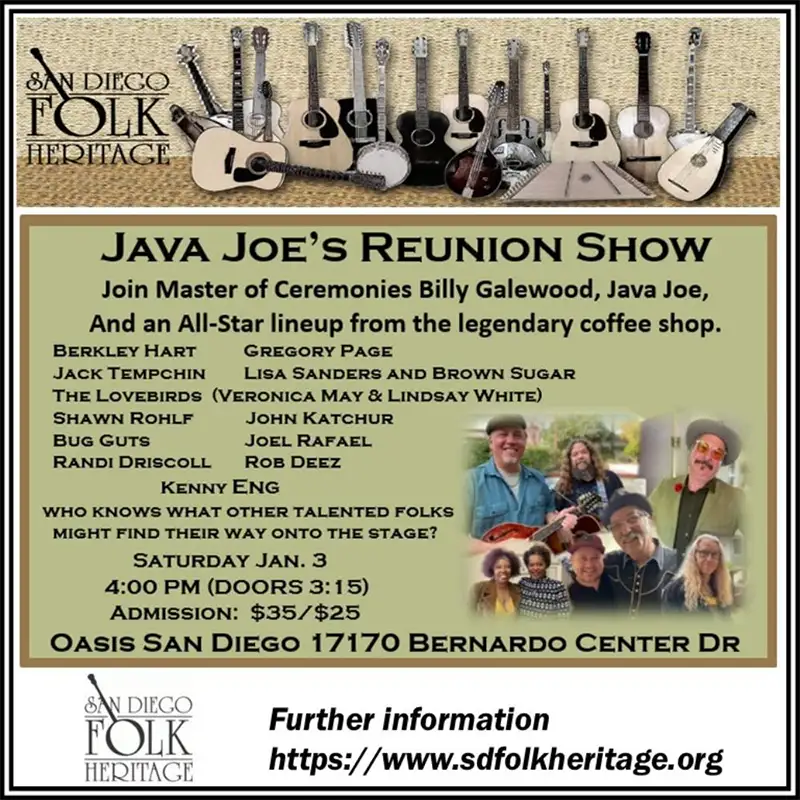Cover Story
JANET BEAZLEY: Making Music in the Here and Now
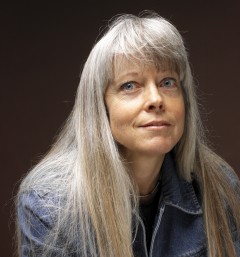
Janet Beazley
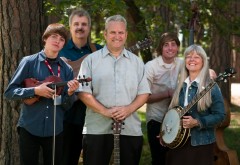
Chris Stuart & Backcountry: Christian Ward, Eric Uglum, Chris Stuart, Auston Ward, Janet Beazley. Photo by Mike Melnyk.
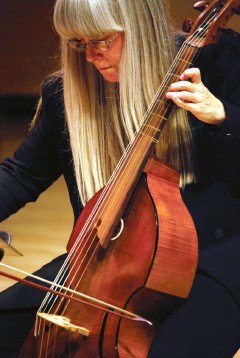
Playing the viola de gamba at UC Riverside
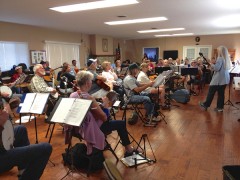
Teaching at the Poway Slow Jam
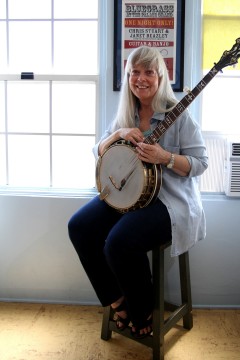
Photo by Dennis Andersen
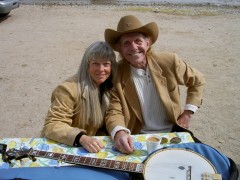
Janet and Doug Dillard
This is a story of how music has developed through time as a human art form. It expresses our deepest human feelings and gives us a window into our past, through the accumulated works of many master composers (well-known and lesser-known). Great musical works of art rely on expert composers, arrangers, and instrumentalists, but the notes on the page are lifeless until they are rendered into sound pressure waves bombarding our ear drums. The live performance of a masterful composition demonstrates the technical prowess of human beings, true. But, it also is an endeavor that exposes the music’s frailty and the performer’s vulnerability. The result is inherently unique — just like human beings ourselves. An understanding of music history can inform even the most modern musical performance; the moment of performance is the most expressive part of the process. Few musicians understand how to navigate the delicate domain of live musical performance, using a thorough knowledge of the forms, styles, and principles that a thousand years of musical practice have bestowed upon us.
I discovered that San Diegans have, in their midst, a local musician who is actively using age-old ideas and techniques to perform and teach music, in the here and now. She is a strong supporter of amateur music-making, while she herself has taken the time to learn about the creative process, instrumentation, and methods that have been used in music for several centuries. She is highly educated and can play multiple instruments. She also strikes a noble balance between honing her own craft through study and performance of multiple musical styles while also disseminating her valuable knowledge via workshops, slow jams, and private lessons. Janet Beazley has a charismatic demeanor and a rare gift for illuminating the manner in which the music that we are performing in the moment is rooted firmly in the passions, creativity, and inspiration of the many talented musicians who came before us. After all the music that has been made throughout history, Janet understands that there is one common thread: music “is finished at the moment of performance.” Janet brings this insight into her performances and teachings of bluegrass and early music.
What Is Special About Live Music?
Music is not a static art — it has changed a lot over time and somewhere along the way, musicians discovered that live performance of music, in the here and now, has an ineffable quality. Musicians, composers, and audiences alike seek out the moment of performance above all other moments in the process of music-making. Live music can be digested by both the intellect or the heart. We have beloved musicians and composers whose artistic expressions satisfy our desire to reveal their deepest thoughts and feelings. Janet is not an ivory tower musician, she is an active performer and through her teaching, she is helping more people have their own experience with performing live music.
Instruments have unique expressive personalities and are an essential element in live musical performance. They have been enhanced over time to allow composers to express more refined ideas. There are other tools of the musical trade, such as musical notation and modern recording technologies, that have a significant influence on the kinds of music that have been created and consumed by audiences. Even the listening experience is ever-changing — these days almost anyone can see live music being performed or learn to play an instrument. By contrast, only a select few people could see live music or learn an instrument several hundred years ago. Janet has learned many instruments, including flute and banjo, even dabbling with mandolin, guitar, and fiddle.
In the modern era, musicians can access a great deal of information about how music is created and performed. We can reflect on the creative ideals that musicians and composers have developed and relied upon over the centuries — ideals like artistic integrity or technical skill. By educating ourselves about how music is made, we enhance the experience of listening. We can become familiar with the greatest composers in history and gain insights into what made their music powerful and lasting. We can stand on the shoulders of giants and understand things from their perspective — our intellectual knowledge has never been more comprehensive that it is today. Janet’s education is as extensive as possible, having earned a DMA (Doctor of Musical Arts) from USC.
As musicians and music fans, we have access to an amazing body of creative work — film scores and broadway — all the way back to the first operas and the church music of the European middle ages. Janet has heavily studied early music, a field of study that looks at pre-concert hall music composed in Europe between roughly the Middle Ages and the Baroque eras. Historically, there have been instruments that were, at one time, the mainstay in musical performance though they have waned in popularity (lutes and harpsichords, for example). By contrast, there are musical instruments that have exposed new sonic frontiers as recently as the late 20th century (synthesizers and special effects, for example).
The mandolin, banjo, and dobro are all quintessential instruments used to perform bluegrass, a style that Janet has a rich personal history with. These instruments have a “bluegrassy” kind of sound, right? But, bluegrass is not only about instrumentation. It is a style that relies heavily on the musician to make informed choices and to interpret music in a collaborative way, playing off of their fellow musicians. Philosophically, Janet’s attitude towards live musical performance beholds one simple idea that has inspired musicians and composers throughout the generations. From the common street musician to the master composer, there is a true affection for the way that music works. Its not about the money or prestige, its about the magic of how harmony and melody collaborate and ignite our senses. That magic mixture is prevelant in both early music and bluegrass — styles that Janet has dedicated herself to understanding, teaching, and performing
The nature of how we enjoy and experience music is inextricably tied to our human virtues and frailties. We are imperfect beings and often the imperfections within the music we compose and perform are the details that electrify us and make the music so powerful. The simple idea of imperfection is more present in live performance than it is in recorded music. Perhaps the imperfection originates in the reverberations of the venue or the effect of humidity acting on the drum heads or even the fluctuation in tempo as the band speeds up and slows down by nearly imperceptable degrees. Through her practice, teaching, and performance Janet seeks to master the blend of technical perfection while allowing for the sonic imperfections that make live performance rich and vibrant.
Times Have Changed, Our Love of Music Hasn’t
In the last few generations, people have found that advances in music are moving pretty fast. In fact, our accumulation of ALL human knowledge is accelerating. This trend has been measured scientifically and the results show that human knowledge is doubling in less and less time. This trend is sometimes called the “knowledge doubling curve” and it shows that until about 1900, human knowledge was doubling every century (approximately). Now, in the 21st century, knowledge is doubling in only a few years. One implication of this fact is that musicians in the 21st century know more and have access to more information than ever before. Plus, we have more advanced instruments, recording devices and creative tools. Despite the changing times and changing fashions, human beings still look to music as a premier art form, capable of incredibly complex expressivity.
One of Janet’s great insights as a musician has been to recognize that her academic knowledge and performance experience is fully realized during the moment of performance. That moment marks the realization of the music blossoming into its complete form. The process has always guided the way great music has been made — the fact that music has been open to reinterpretation time and time again has helped it stay current and relevant. Indeed, there is a fundamental imperative that music be performed in the moment as a collaborative and expressive process between human beings. Otherwise, music risks becoming an artifact like those we find in our museums.
Bluegrass and Early Music
Bluegrass music allows musicians tremendous latitude within a set of agreed-upon constraints. Janet often guides people through the process of learning how bluegrass is structured and how they can develop the ability to play in the moment, like she does. These events are like loose workshops where musicians can learn, but are also actively playing and practicing their craft — with Janet’s informed guidance.
Janet has acquired a signifiicant education in music including a DMA (Doctor of Musical Arts) in early music from USC. She studied flute as an undergrad. Before completing her DMA in early music under the tutelage of the late, great James Tyler, Janet was already in the pipleline to complete a Ph.D. Largely due to the influence of James Tyler, Janet became fascinated with both the instrumentation and the music of bygone eras — specifically, the music of the Middle Ages through to the baroque period, also known as “early music.” Technically speaking that encompasses one thousand years of development and social change, from roughly 950 — 1750 AD.
By the time she encountered her early music studies, Janet already had significant training as a flute player and was concurrently USC’s adjunct professor of historical flutes and recorders. Her discovery of early music was concurrent to her learning the banjo (and, to a lesser degree, guitar and mandolin). The addition of new, stringed instruments to her arsenal brought her closer to traditional bluegrass music as well. She found that early music, like bluegrass was flowing a malleable, skeletal structure in which she could imprint her own ideas on the music during the moment of performance. “You just have to know more about how [pieces of early] music [were] supposed to go because its notated in a very skeletal way.” Janet explains, “Its essentially Western European ‘classical’ music, pre-1750, with an emphasis on the performance practice… the written page, if it exists, does not really tell you what it sounds like.” Likewise, bluegrass allows musicians to interact with a “skeletal” structure built from basic musical building blocks. They must have a certain amount of requisite knowledge and there is a repertoire that is common to all bluegrass players. But as a listener you are unlikely to hear the same performance twice — even if you are hearing the same composition from the same band twice!
At this point, it helps to be aware that some early music composition was contemporary with well-known European composers like JS Bach. But, typically the early music scores that Janet is performing do not have the same “road signs” as the compositions by the concert hall composers. For example, dynamics markings, instrument indications, repeats, or even bar lines are not present. These variables open up a lot of interpretive real estate. Musicians with advanced educations tend to also be well-informed when it comes to interpreting these skeletal compositions.
The mass populace is aware of music composed by Bach and Handel, but early music offers up an extensive list of master composers that are far less-well known to the average listener. Janet’s discovered that many of the early music composers were true masters, despite having diminished notoriety compared to likes of Bach, was an inspirational discovery — “There were armies of fabulous composers”.
James Tyler was hired in order to develop the original early music program at USC. Early music has since blossomed and many institutions and universities now have early music programs. This has happened because many of the early music composers were so good that musicologists and performers wanted to access their works in a more informed way. “Its really good music,” Janet declares emphatically. “Josquin de Prez, Dufay — they were the Beethoven of the [15th and] 16th century… they are giants.” Their music was composed and performed with the understanding that, as Janet says, “the composition is finished at the moment of performance.” This paradigm helps to explain why the music was composed to be intentionally open to interpretation.
As you are now aware, Janet primarily focuses her performance and teaching on bluegrass and early music. The invention of bluegrass (if there can be such a pedestrian way to describe its origins) is largely attributed to a Kentucky-born mandolin player named Bill Monroe. Bluegrass is often performed on banjo, guitar, mandolin, dobro, fiddle, and bass. In some circles there is great urgency and concern around any involvement of electronics (electric pickups, etc.) — even to the point of banning electric bass! In a bluegrass band, musicians follow a musical form and they learn to play specific melodies. There is a strong improvisational component as well because bluegrass musicians frequently trade solos and switch back and forth between playing lead parts and playing accompaniments. Bluegrass, like blues and jazz, is a musical style that allows for a lot of interpretive latitude. The interpretive context and the thrill of seeing how the music is performed in the moment is part of its appeal to performers and listeners alike.
One of Janet’s most active contributions to San Diego’s bluegrass community is her commitment to teaching informal, but structured slow jams. “In my slow jams [I teach] the fundamentals [as well as] what do you do when you’re not playing solos.” The slow jams incorporate a broader variety of instruments, beyond traditional bluegrass — sometimes people bring dulcimers or other instruments, for example. The slow jam is partly social and partly educational; Janet’s lessons are focused on the repertoire, techniques, and etiquette that one needs to understand in order to develop a good grasp of how to play bluegrass.
During a slow jam, there is some guided discussion that helps to prepare everyone for a group collaboration. Typically, the group kicks off a selection from traditional bluegrass repertoire, they play the melody and then those who are so inclined may take a solo, taking turns. This model and the expectations between established bluegrass musicians is based on a baseline extrapolated from Bill Monroe recordings. The traditional bluegrass repertoire includes many first generation bluegrass groups. Some of the most common names you’ll hear are Flatt & Scruggs, Bill Monroe, Jim and Jesse, and the Stanley Brothers.
Coincidentally, Janet’s work with early music is also a pursuit that allows for a lot of interpretive latitude. Both repertoires owe largely to the existence of amateur musicians and are composed with the performer in mind. However, in both contexts it is the case that amateur in no way implies a lack of skill or talent. Instead, amateur musicians are informally trained – often they are self-taught or have developed their own skills and talents independently. Janet told me that in the days of early music’s origins (middle ages to the baroque period) many “amateurs” were indeed more respected socially than the pros. In the aristocratic courts, “the amateur musician was socially way above the professional musician… it was the amateur that was admired”, explains Janet.
It could also be argued that the adoption of music by the amateur musician in those days created a market for music and helped lead to the mass printing of music scores and music texts. Cultivated amateurs from the rising middle class had the time and resources to consume these printed materials. “I really believe in amateur music-making and helping to foster that,” Janet is quick to point out.
Bluegrass music not only allows for a great deal of interpretation but actually requires it! This challenge is at the heart of Janet’s passion for bluegrass, but it is also central to her passion for early music. Bluegrass, like early music, relies heavily on contributions by amateur musicians specifically. Early music is, in part, defined by the fact that it predates the modern notion of a concert hall and the symphonic performances that we are now familiar with. In the days of early music, neither was the music prepared for a concert hall nor were the instruments used common to what we see in a modern symphonic orchestra.
“Early music by and large was patron-oriented,” meaning that it was paid for by private interests. “The classical music that the mass populace is familiar with is stuff that you’d hear at concert halls,” explains Janet, referring to the popular concert hall compositions by the likes of Beethoven and Bach. Concert hall presentations rarely expect the orchestral players to exercise a significant amount of interpretation when performing the music.
Janet started her music career performing on the flute. She originally aspired to be an orchestral flute player and perhaps a tenured professor of flute somewhere. Her innate talent and support by James Tyler quickly helped her advance in many areas of personal musical development, simultaneously. At one point she was studying at USC, while teaching at multiple institutions and even touring with a bluegrass band. In addition to all that, she was also teaching bluegrass workshops and early music workshops.
Eventually, developments around early music shifted her commitment to the banjo, from flute. She joined the early music ensemble at USC, changed her degree program and the rest is history. One significant effect of this instrumental change was the switch from treble lines (playing the flute) to bass lines (exploring guitar and banjo). Her awareness of harmony expanded as she began working with stringed instruments. Subsequently, this informed her musical perspective as well as changed the approach she had towards early music and bluegrass.
Where You Can Learn More
There are many opportunities for beginners and advanced musicians to start working on their own understanding of bluegrass and early music, right here in San Diego. Janet helps to coordinate and teach a variety of workshops and slow jams throughout the year. Here are some of the highlights that you can consider participating in, if you are so inclined:
Summergrass
Janet will be leading bluegrass slow jams at this year’s Summergrass festival. Summergrass is Southern California’s premier bluegrass festival. This year marks the 13th annual event and it runs from August 14-16. You can find out more information about tickets, performances and workshops on their website
http://www.summergrass.net.
SDBS 3rd Monday Bluegrass Slow Jam: 7-8:30pm
$5 for SDBS members, $10 for non-members
Mid-City Community Music School, a collective of musicians and instructors in the mid-city/North Park area sponsor this slow jam. This event is co-sponsored by the San Diego Bluegrass Society:
(on the campus of Our Savior’s Lutheran Church in North Park, behind the church sanctuary)
4011 Ohio St. San Diego, CA 92104
www.sdcommunitymusic.org
www.sandiegobluegrass.org
Poway Folk Circle 1st Sundays Bluegrass Slow Jam: 2:30-4pm
Fee: $5
Poinsettia Sr. Park Clubhouse
13648 Edgemoor St. (please park on the street, not in numbered spaces), Poway, CA. 92064
For more info go to the PFC meetup calendar: http://www.meetup.com/Poway-Folk-Circle/events/
Poway Folk Circle 3rd Sundays Old Times Slow Jam: 2:30-4pm
Old-Time music is both a traditional music steeped in the British/Celtic/African sounds of the southeast U.S., and a vibrant, contemporary one that is always changing. It’s more of a fiddle tune-based music than bluegrass, so we concentrate on learning the tunes slowly, by ear, and play them over and over, as in a typical old time music session. We also work on chord changes and rhythm playing. All acoustic instruments and learning levels are welcome.
Fee: $5
Poinsettia Sr. Park Clubhouse
13648 Edgemoor St. (please park on the street, not in numbered spaces)
Poway, CA. 92064
For more info go to the PFC meetup calendar: http://www.meetup.com/Poway-Folk-Circle/events/
* Dates of the Poway slow jams are subject to change, so please double check the meetup sites before attending for the first time.
The Bluegrass Slow Jams are ideal for beginning to intermediate guitarists, fiddlers, banjo, dobro, bass, and mandolin players (and players of any other acoustic string instrument!) interested in learning bluegrass repertoire and jamming etiquette, or just playing and singing music with other folks. Each month we learn a new song or instrumental at a slow, easy pace. The primary focus is on singing and changing chords, plus players can try solos (in their instrument group) if they want to.
Janet says that “the vibe for all the [aforementioned] jams is very upbeat and friendly.” These are not tight-knit cliques — quite the contrary. These jams are managed and designed around making musicians feel supported and welcome. Provided that you have an instrument and a general facility with it, you will be able to begin learning right away. Slow jams are “slow” because the group plays repertoire under tempo.
The jam does challenge those who attend to actually play music most of the time. There is a lot of collaboration and jamming, but Janet’s events are also guided; Janet typically stands in front and helps to explain the music and she provides tips on how to approach playing collaboratively. You may learn what a chorus is or how to use tricks and listening to find a melody on your instrument. Janet assures us, “Its okay for newbies to come… I give enough guidance [that] if someone wandered over with a guitar, they’d do okay and have fun.” That isn’t to say that more advanced players have little to gain at the slow jams. “Even players that could handle a regular jam like coming to the slow jam because they can try out solos.”
**************
Janet plays banjo and sings with the California bluegrass band Chris Stuart & Backcountry, and in the folk duo Chris Stuart & Janet Beazley. She has toured extensively with CS&B throughout the U. S., Canada, the United Kingdom, Europe, and the Middle East. Janet has taught bluegrass banjo, harmony singing, music theory and song writing at many workshops, including Rivertunes, Midwest Banjo Camp, American Banjo Camp, Suwannee Banjo Camp, Augusta Heritage Center Bluegrass Week, California Bluegrass Association Bluegrass Week, Banjo Camp North, Munich Banjo Camp, and Sore Fingers Week in the UK.
Janet taught early music and bluegrass at UC Riverside for many years, and is a sought-after clinician at early music and recorder workshops here in the West. She currently teaches bluegrass banjo to students of all levels. She also teaches traditional and early flutes, recorders and whistles, beginning mandolin, beginning dobro as well as viola da gamba.


